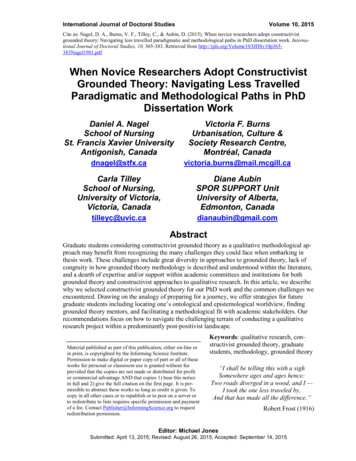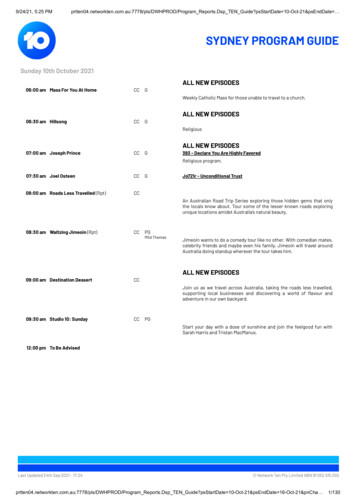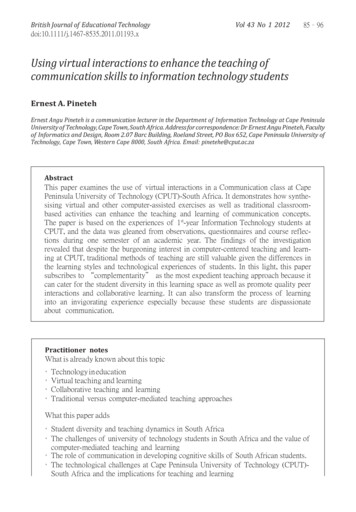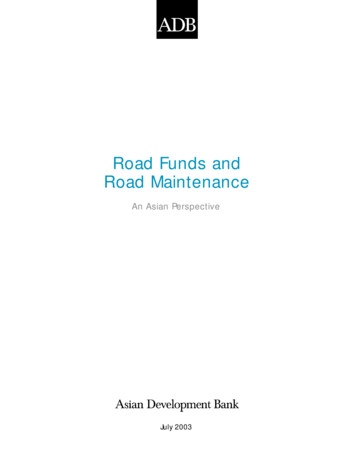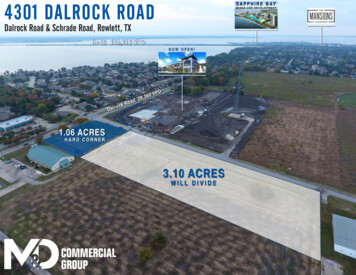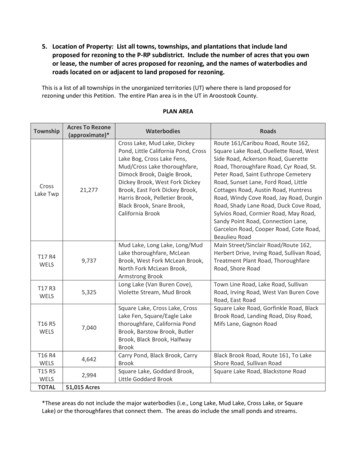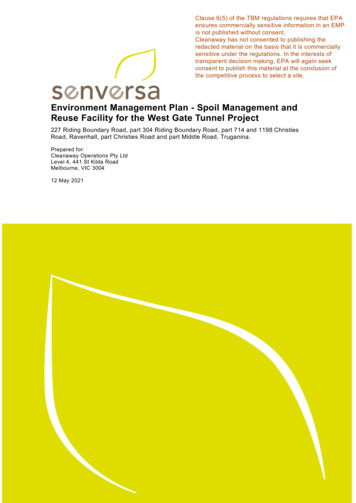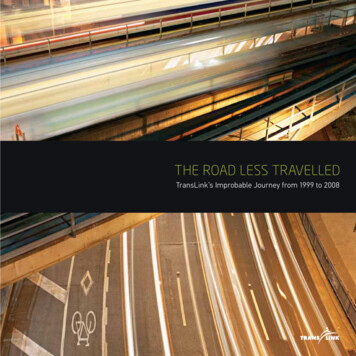
Transcription
THE ROAD LESS TRAVELLEDTransLink’s Improbable Journey from 1999 to 2008
Copyright 2008 by TransLinkAll rights reserved. No part of this book may be reproduced, stored in a retrieval systemor transmitted, in any form or by any means, without the prior written consent of thecopyright holder.TransLink1600 – 4720 KingswayBurnaby, BC V5H 4N2Canada604-453-4500www.translink.bc.caWritten by Trevor WalesRevised by Heather Prittie and Jhenifer PabillanoEdited by Patricia G. WebbPreface by Mike HarcourtLibrary and Archives Canada Cataloguing in PublicationWales, Trevor, 1986The road less travelled: TransLink’s improbable journey from 1999 to 2008 / writtenby Trevor Wales; edited by Patricia G. Webb; preface by Mike Harcourt.ISBN 978-0-9810441-0-11. TransLink (Firm)--History. 2. Local transit--British Columbia--Vancouver MetropolitanArea--History. 3. Transportation and state--British Columbia--Vancouver MetropolitanArea--History. I. Webb, Patricia G. (Patricia Grace), 1959- II. TransLink (Firm) III. Title.HE4508.B7W35 2008388.409711’33C2008-903858-4
CONTENTS1Preface by Mike Harcourt512The TransLinkFamily of Companies55591- 56911152-2122252933373-41424549Ignition: Pre-history - 1999Timeline 1897-1988TransLink: A New Modelfor Managing TransportationLife Before TransLinkFirst StepsPathfinding: 1999 - 2001Timeline 1999-2001Leaders are Appointedand the Transition BeginsEarly Transit andRoad ImprovementsThe Vehicle Levy StallsTransit Strike CrawlsAcceleration: 2002 - 2003Timeline 2002-2004New LeadershipRevitalizes TransLinkA New Push for Stable Funding4-6162656973775-81828588Millennium Line SkyTrainOpens Amid ControversyThree-Year Plan Marksa Fresh StartU-Pass Earns High MarksFrom University StudentsMomentum: 2004 - 2007Timeline 2005 -2007Building RelationshipsThroughout the RegionA New Plan, a 10-Year Outlook,and a New DealThe Canada Line DebatesMajor Shifts in Governance,Mandate, and FundingNew Destinations:2008 and BeyondTimeline 2008-2040Expanded Mandate MakesBigger Projects PossibleAwards
PREFACEby Mike HarcourtMike Harcourt is a former premier of British Columbia,mayor of Vancouver, and city councillor. His work has helpedB.C. become one of the most livable regions in the world.Today, he continues to champion sustainable developmentand livable communities worldwide, and has been honouredfor his efforts with the Woodrow Wilson Award for PublicService, and the Canadian Urban Institute's Jane JacobsLifetime Achievement Award. In 2006, he chaired the PrimeMinister's Advisory Committee for Cities and Communities,and co-chaired the National Advisory Committee on theUN-HABITAT World Urban Forum.
PrefaceIn the 1990s, transportation was the top issue in theLower Mainland. Skyrocketing rates of car ownership andgridlock on the roads made commuting a nightmare, as wellas challenging efficient goods movement and producingenvironmentally damaging emissions. The provincialgovernment and leaders of the 20 municipalities making upthe Greater Vancouver Regional District (GVRD) knew at thattime this situation couldn’t go on.The solution, the GVRD believed, lay in a regional response.With no other transportation model coming close to fittingits needs, Greater Vancouver blazed its own trail, developinga regional agency with unprecedented authority to tacklethe crisis. Through negotiations with the Province of BritishColumbia, TransLink was born in 1999: a unique, made-in-B.C.solution unmatched by any transportation authority inthe world.1Opening in 2009, the new Canada Line provides a rapidtransit link between Richmond, Vancouver, and the VancouverInternational Airport. The line offsets the need for more roadsand bridges, adding the transit capacity of 10 major roadlanes to a corridor containing one-third of our region’s jobs,and one-fifth of its population.And TransLink’s work has helped the region reduce itsenvironmental impact. New transit vehicles run on cleanerdiesel fuels that use less fuel and produce far feweremissions, and 141 diesel-electric hybrid buses are evencleaner. TransLink also continues investing in zero-emissionelectric trolley buses, replacing its entire trolley fleet tolow-floor models. Cycling infrastructure and bike access totransit are also major priorities: most TransLink buses arenow equipped with bike racks, and bike lockers are in manySkyTrain stations.MIKE HARCOURTTransLink has three key features. First, it is responsible forcreating a transportation network to move people and goodsefficiently, and building capacity to handle population growthand meet the municipalities’ economic plans. Second, it isresponsible for both the major road network and the publictransit system - in almost every other city, these areas are theresponsibility of separate departments. Third, it has the meansto raise its own funds through taxation—a key change from itspredecessor BC Transit, who had to appeal to the province forfunding every year.The structure works. In the years since its formation, TransLink’swork has brought a wealth of benefits to our region.For instance, after a decade that saw virtually no expansionof transit services, TransLink increased transit service hoursby 32 per cent since 1999. The bus fleet expanded from 1092vehicles to over 1400. Specialized services like communityshuttles and rapid bus lines have been added, and ridershipjumped due to programs like the Vancity U-Pass.TransLink also builds key roads and bridges to keep the regionmoving, expanding its capital budget from 600 million in 1999to about 5 billion in 2008. Projects include the new GoldenEars Bridge opening in 2009, connecting Maple Ridge andPitt Meadows to Surrey and Langley. The bridge ties directlyinto the road upgrades of the province’s Gateway Program,improving regional traffic flows immensely.What will blow everyone’s socks off, however, is TransLink’snext five to seven years. With 2008 bringing a new boardstructure and more dedicated funding, TransLink can nowtruly deliver on its promise of transporting people and goodswhile responding to the needs of municipalities.Aligning with provincial plans, TransLink is already planningtwo new rail rapid transit lines, the Evergreen Line and UBCLine, as well as an extension of the Expo Line. Seven morehigh-capacity rapid bus lines will also be launched in MetroVancouver. TransLink’s new real estate function is looking toshape smarter, denser city development early on. Throughthese projects and more, TransLink is moving toward acomplete regional transportation system, offering a viablealternative to the car, and linking city centres and corridorsthat are greener and more compact.So enjoy this book: a thorough look at the monumental taskof building TransLink, and the successes and challengesovercome in its first decade of growth. There are manyamazing achievements in these years. What comes next willbe even more spectacular.
2SERVICESOPERATINGSubsidiariesBUS & SEABUSContractorsCOAST MTNBUS CO LTDDISTRICT OFWEST VANCONTRACTEDSERVICESCOMMUNITYSHUTTLESPUBLIC TRANSITSKYTRAINBC RAPIDTRANSIT CO LTDWEST COASTEXPRESSWEST COASTEXPRESS LTDALBION FERRYFRASER RIVERMARINE LTDROADS & IGENTTRANSPORTATIONSYSTEMSTransLink is responsible for planning,financing, and managing transportationmodes and services in the MetroVancouver region of British Columbia.The first North American transportationauthority responsible for both roadsand transit, TransLink also overseestransportation demand management,cycling facilities, AirCare vehicleemissions testing, and intelligenttransportation systems technology.This model allows TransLink to planthe network as a strategic whole, andhas drawn acclaim from transportationexperts worldwide.VIA RAIL7 CONTRACTORS(8 CONTRACTS)HANDYDARTMAJOR ROADNETWORKCP RAILMUNICIPALITIES& MINISTRY OFTRANSPORTATIONAND HIGHWAYSJACK BELLB.E.S.TPACIFIC VEHICLETESTINGTECHNOLOGY LTDENVIROTESTCANADA592040 BC LTDCoast Mountain Bus CompanyThe Coast Mountain Bus Company(CMBC) was created on April 1, 1999,and was formerly known as BC Transitwithin Metro Vancouver. It is TransLink’slargest subsidiary, with a current fleet ofmore than 1,400 buses and over 5,000employees. CMBC operates over 96 percent of the region’s bus service, whichincludes 208 state-of-the-art clean dieselbuses and 228 zero-emission trolleys.Contracted companies, including WestVancouver Blue Bus and communityshuttle services, operate the remainingfour per cent of regional bus service.CMBC also operates the SeaBuspassenger ferries, a vital link betweenNorth Vancouver and downtownVancouver. These two vessels, whichcarry up to 400 passengers each, werea world first when launched in 1977. TheSeaBus crosses Burrard Inlet 45,000times a year and carried more than 94million passengers by 2007.BC Rapid Transit CompanyThe British Columbia Rapid TransitCompany operates the internationallyrespected SkyTrain advanced rapidtransit system, which connectsdowntown Vancouver with Burnaby,New Westminster, and Surrey.TransLink’s SkyTrain is the world’slongest automated light rapid transitsystem. SkyTrain began with the ExpoLine, built for the Expo 86 World Fair,with the Millennium Line added in 2002.The two lines have a combined total of49.5-kilometres of track and 33 stations.The system uses the same family oflinear induction motor-driven trainsfound in Toronto, New York, and KualaLumpur. SkyTrain is one of the country’slargest transit services, carrying over65 million people every year.West Coast ExpressWest Coast Express runs the rail andbus service that connects Mission,Maple Ridge, Pitt Meadows, PortCoquitlam, Coquitlam, and Port Moodywith downtown Vancouver. It is thetravel choice of over 9,000 a day and
The TransLink Family of Companies3THE TRANSLINKFAMILY OFCOMPANIESover two million customers a year, andmakes the 65-kilometre commuteto downtown in just over an hour.WCE’s five trains are vital for thenortheast-sector, taking customersinto downtown Vancouver during themorning peak period, and back totheir communities in the aſternoonpeak. The company’s mission is forcustomers to love riding their service;amenities include computer plug-insand a cappuccino bar. The system’sdouble decker coaches are also climatecontrolled, wheelchair accessible, andequipped to carry bicycles.Intelligent Transportation SystemsIntelligent Transportation Systems (ITS)involves the application of computerand communications technologies tomaximize the efficiency and safetyof the transportation network. ITSminimizes congestion, improvessafety and security, reduces harmfulemissions and provides access tobetter traveler information. ITS enablesintegration and interoperability betweensystems to support goods movementand intermodal travel, allowingagencies in the region to provide aseamless, smoother and safer tripthroughout the network.Fraser River Marine TransportationThe Albion Ferry Service is operated byFraser River Marine Transportation Ltd.Currently, the Albion Ferry is the onlyFraser River crossing between the PortMann and Mission bridges. Over 70,000crossings between Langley and MapleRidge are made annually by two vehicleferries. Ferry service will end when thenew six-lane 800 million Golden EarsBridge opens in 2009.Pacific Vehicle Testing TechnologyAirCare, created in 1992 to address thedeteriorating air quality of the LowerFraser Valley, provides emission testingand identifies vehicles with excessemissions. Excess polluters are requiredto make repairs to reduce emissions ortheir license and insurance may not berenewed. Most of the region’s passengercars, light-duty trucks, and motorhomes are required to have AirCareemissions inspection. New vehicles areexempt from testing until they are sevenmodel years old. Pacific Vehicle TestingTechnologies delivers inspection inMetro Vancouver and the Fraser Valley.These centres will perform some562,000 inspections in 2008.AirCare has been a big success—12 years after its inception, vehiclegenerated emissions in the regionwere reduced by 71 per cent, withAirCare-related repairs responsiblefor 29 per cent.Transportation Demand ManagementTransLink’s Transportation DemandManagement group aims to reducesingle-occupant vehicle trips withinMetro Vancouver—to improve theair, fight climate change, and reducecongestion. Through its CommutingOptions program, the group servescommuters with cost effectivealternatives and carpooling.One program, Employer Pass, offersa 15 per cent discount on a transitpass when 25 or more employeesfrom a company participate. By 2007,over 240 companies and 15,000employees were on board, all playingan important part in converting vehicletrips to transit trips.Park and Ride sites are foundthroughout Metro Vancouver, and all20 are located at major bus loopsand SkyTrain stations so commuterscan use transit for a portion of theirtrip. TransLink also assists severalcarpooling programs, such asJack Bell Ride-Share, a not-forprofit organization offering an onlineride-matching database for casualridesharing partners, in addition toformal car and vanpool groups. TheCompany Car is a corporate car-shareprogram created in partnership withthe Cooperative Auto Network. Itprovides businesses with access tocorporate vehicles so they can saveon gas and parking costs.
4
Chapter 1 Ignition: Pre-history – 1999IGNITION :CREATING THEWORLD'S FIRSTMULTI-MODALTRANSPORTAUTHORITYAn idea is born in the early 1990s and steadily grows. The GVRDmakes transportation its first priority. Then the province downloadsroads responsibility to municipalities. In 1999, to everyone’s surprise,the province and region agree on a multi-modal transportationauthority. Funding decisions? Those would come later.5
6THE IDEA IS BORN19931962BC Electric RailwayCompany is purchased forthe Province by PremierW.A.C. Bennett, and isoperated by BC Hydro.1897BC Electric RailwayCompany founded, operatingin Vancouver and Victoria.1976The system is assigned toBureau of Transit Services,later named BC Transit.GVRD and the Provincerelease Transport 2021 plan,proposing integration ofland use and transportationplanning, and major serviceimprovements.
Chapter 1 Ignition: Pre-history – 19997199819971996GVRD’s Livable RegionStrategic Plan envisionsa regional transportationauthority.The BC governmenttransfers responsibilityfor secondary highways tomunicipalities.George Puil, GVRD Chair,declares transportation themost urgent priority.FEBRUARY GVRD boardidentifies principles tonegotiate a new regionaltransportation authority.APRIL Negotiations betweenProvince and GVRD begin.OCTOBER Negotiatorssign and submit a finalagreement to create theGVTA (TransLink).FEBRUARY Ratified by theGVRD and the Province, theagreement is announcedby Joy MacPhail, ministerresponsible for transit.JUNE Province announcesthe Millennium Line.JULY 29 GVTA Act approvedby provincial legislature.OCTOBER First GVTA boardof directors meeting is held.NOVEMBER Ken Dobell isappointed the first CEO ofthe GVTA.DECEMBER BC Transitbus operations in theGVRD become a TransLinksubsidiary - the CoastMountain Bus Company.
8
Chapter 1 Ignition: Pre-history – 19999TRANSLINK: A NEW MODELFOR MANAGING TRANSPORTATIONOn April 1, 1999, a transportation agency unlike any other wasborn. That day, seven Lower Mainland municipal officialsboarded buses, SkyTrain, SeaBus, and West Coast Express,heading for a Burnaby boardroom and the official ceremonyto launch the Greater Vancouver Transportation Authority,also known as TransLink.TransLink'sfounders createdan agency with thepower to improvethe transportationnetwork on multiplefronts, intendedto bring dramatictransportationenhancementsto the regionas a whole.TransLink was the world’s first multimodal transportation authority, taskedwith creating an efficient transportationnetwork to move people and goodswell. To help build this network, thenew agency had authority over bothmajor roads and public transportation,and would coordinate transportationdevelopment with land use plans fromthe 20 municipalities of the GreaterVancouver Regional District (GVRD).country’s third largest urban region.Greater Vancouver residents were alsoclamouring for action: just three yearsearlier, transportation was rated thetop issue in the region, and 50 per centof residents believed that better transitwas the solution.and coordinate transit and land useplanning. This integrated approach notonly made sense from a funding andgovernance point of view, it also meantoperational changes could be made torelieve congestion and pollution in oneof the country’s fastest growing areas.At the time, Greater Vancouver hadthe highest per capita automobileownership in Canada, and the numberof registered vehicles in the LowerMainland increased at nearly three perhour. Sixty per cent of commuter cartrips crossed municipal boundaries,but the road network lacked thestructured approach required toeffectively manage it.And so, from the growing transportationcrisis, TransLink was born. The new andpromising idea behind the organizationwas that, unlike its predecessor BCTransit, TransLink would go beyondpublic transit. Bestowing the newauthority with responsibility fortransit and major roads in the region,TransLink’s founders created anagency with the power to improve thetransportation network on multiplefronts, intended to bring dramatictransportation enhancements to theregion as a whole.By drawing together experiencedstaff, a variety of revenue sources, andregional growth strategies, TransLinkaimed to benefit all businesses andresidents within the GVRD—fromcyclists, transit users, and carcommuters, to those transportinggoods and services.In short, transportation conditionswere far from what was needed tosupport the thriving economy ofCanada’s Asia Pacific gateway and theThrough the GVRD, TransLink wouldwork with all municipalities in theregional district to develop andmaintain a major road network,
10
Chapter 1 Ignition: Pre-history – 199911LIFE BEFORE TRANSLINKCompared to most major metropolitan areas in NorthAmerica in the mid 1990s, public transit in the GreaterVancouver region was an anomaly.“ BC Transit wasn'tdoing a bad job, butit was just transit.And it was verymode-specific, yetthe challenges aremulti-modal, ”Clive RockThe Vancouver metropolitan areawas one of only a few regions in NorthAmerica where transit was operated bythe provincial government, rather thanrun at the local level. This was becausepublic transit in Vancouver had beenchiefly run by a private company, theBC Electric Railway Company, whichhad operated both the streetcars andthe electrical system since 1897. BCElectric was purchased by PremierW.A.C. Bennett and his Social Creditprovincial government in 1962, andafter that the transit system wasjuggled from one provincial entity toanother. At one point, transit was adivision of BC Hydro, with excess powerfrom the grid transferred to streetcarsand trolleys.Eventually, the system was handedoff to the Bureau of Transit Servicesin 1976, and then to the Urban TransitAuthority in 1978, and later renamedBC Transit.BC Transit became a sprawling andcomplex entity. A provincial crowncorporation, it provided all services,controlled expenditures, and establishedcontracts. Its services were dividedgeographically; two separate units eachresponsible for Victoria and Vancouver,and a third which oversaw municipalsystems in communities throughoutthe province. For Vancouver, a separatecommission of seven elected municipalofficials made pricing decisions,including fare increases.But BC Transit’s major problem wasits funding. Instead of having a stableincome, the organization was requiredto go to the provincial governmenteach and every year. The result wasfluctuating and unpredictable revenue,making implementation of long-termplans effectively impossible.“BC Transit wasn’t doing a bad job,but it was just transit. And it was verymode-specific, yet the challenges aremulti-modal,” said Clive Rock, a formerBC Transit executive who becamehead of GVRD’s transportation planningin the mid-1990s, and later servedas TransLink’s director of strategicplanning. The regional district did nothave control over public transit, and thatwas something they wanted to change.“We thought there was a need for anew kind of approach, but this wasn’tjust some dream that came aboutovernight. The region had been tryingfor decades to get something off theground,” he recalled.Laying the foundationsThe GVRD’s evolving vision for regionaltransportation can be tracked throughits planning documents published inthe 1990s, intended to shape the faceof the region for years to come. Threeof these documents provided keytransportation priorities and strategieswhich would later lead to the creationof TransLink.
12“ We thought there was a need for a new kind ofapproach, but this wasn't just some dream thatcame about overnight. The region had been tryingfor decades to get something off the ground. ”Clive Rockformer head of GVRD transportation planning, and TransLink’s first directorof strategic planning
Chapter 1 Ignition: Pre-history – 1999KEN CAMERONAs manager of the GVRD policy and planningdepartment in the 1990s, Cameron was anearly visionary of regional transportationplanning, and one of the key figures innegotiating the creation of TransLink. Hewas appointed CEO of the British ColumbiaHomeowner Protection Office in 2004.CLIVE ROCKClive Rock is a former BC Transit executivewho became head of GVRD’s transportationplanning in the mid-1990s, and later served asTransLink’s director of strategic planning. Rockplayed a central role in developing the conceptof a regional transportation authority, and wasa lead negotiator in the high level discussionsthat led to the founding of TransLink.The first was Creating Our Future,which established measurable goalsand targets in many areas of planning,and was approved by the GVRDboard of directors in July 1990. Mostsignificant, from a transportationperspective, was that the GVRD and itsmember municipalities committed to atransportation policy that gave walking,cycling, transit, and goods movementhigher priority than the privateautomobile. The region’s growingdependency on cars was causingconcerns about air quality, land use,and community choices.Livable Region Plan targetstransportationThe agenda set out in Creating OurFuture directly influenced two otherkey documents: the Transport 2021and Livable Region Strategic Plan, bothof which were based on integratingland use and transportation planning—an approach to regional planningnever before seen in GreaterVancouver.Transport 2021 was completedjointly with the province in 1993.This document set specific strategiesfor how to achieve increasedtransportation choice, as set out byLivable Region Strategic Plan—thechief methods were to manageland use, transportation demand,and transportation supply. But thegoals it set were lofty, including theconstruction of three new rapid transitlines, and doubling the 1992 bus fleetfrom 950 to 1800 buses by 2006, aswell as adding new high-occupancyvehicle carpool lanes and additionaltraffic lanes for general traffic.13“There were all these wonderful planslike Transport 2021, but if you look atthat document, it doesn’t actually saywho would do what, when, and how,”Rock said. “It was very easy to approvebecause it was very abstract. Therewere these high-level, shimmeringvisions of the future, but they didn’tsay ‘OK, if you want to get there, this iswhat you have to do tomorrow.’”A key proposal in Transport 2021was some form of road user costto help fund the major transit fleetexpansions, and transit and roadinfrastructure improvements. KenCameron, manager of the GVRD policyand planning department and one ofthe key figures in developing the legacyplans, viewed transportation as amunicipal service like any other.“You can look at it as if it’s no differentfrom water or sewers, or any otherkind of utility,” Cameron said. “Sowhat are the financing principlesbehind those utilities? They’re userpay, essentially. You use water andsewer revenues to pay for water andsewer services, and the aim wasto get transportation services to beautonomous, self-financing, selfconstructing utilities.”At 1.5 billion, Transport 2021 was toorich for the provincial government, whoturned to the GVRD to contribute. Butwithout any say in how the plannedtransit system would operate, theGVRD said no.The Livable Region Strategic Plan wasthe GVRD’s first growth managementstrategy. It was derived fromCreating our Future and also metthe requirements of new provinciallegislation on growth managementstrategies. Transportation playeda key role in the plan—increasingtransportation choice was one of itsfour main principles. While it wasonly a vision on paper, the plan wasnonetheless a critical moment inTransLink’s pre-history. The Plan waseventually adopted by the GVRD in 1996.GVRD aims to take centre stagein transport planningIn September 1996, the first of severaltransportation governance workshopswere held, for which Ken Cameroncredits Clive Rock’s insight. The twowere already friends prior to workingat the GVRD, and would carpool to andfrom work in Cameron’s blue Pontiac6000 station wagon.“It was Clive who basically said whenhe came on the scene, ‘If there’s goingto be something different from juststraight-up capital provincial projects,and we have to put local money in,there has to be some say in localgovernance,’” Cameron said. “That wasreally important insight and influencefor me, and he guided that wholeprocess.”Several options for governance werepresented during the first workshop.The GVRD ultimately reached theconclusion that it wanted to play thecentral role in regional transportation,and move toward a solution on a broadand strategic level, while finding a wayto use existing tax sources to buy aplace at the table.
14“ People had been trying for 20 years and no onehad even come close. No one was out to sabotagethe process, they just thought it was improbable. ”Bob Lingwoodformer BC Transit general manager, Victoria
Chapter 1 Ignition: Pre-history – 199915FIRST STEPSIn December 1996, two key events allowed the concept of aregional transportation authority to gain momentum. The firstwas the election of George Puil as chair of the GVRD board.A veteran of the parks board, Vancouver city council and theGVRD board for 27 years, Puil had one thing in mind when hebecame chair: transportation.GEORGE PUILAn acknowledged founder of TransLink,George Puil served as its first chair, from 1999to 2001. When he was elected chair of theGreater Vancouver Regional District, a post heheld for six years in the 1990s, Puil declaredtransportation the number-one politicalpriority—and headed the negotiations withthe province to create the Greater VancouverTransportation Authority. He served as a publicrepresentative for 40 years, first elected in1962 to the Vancouver Parks Board, then toVancouver City Council in 1976. Puil was acouncillor until 2002—the same year he wasnamed Transit Advocate of the Year by theCanadian Urban Transit Association.“In my inaugural speech, my prioritywas going to be transportation,because polls had been done andeverybody was complaining,” Puil said.“Ironically enough, both Ken Cameron[GVRD policy and planning manager]and Clive Rock [head of GVRD transportplanning] had been working on thisvision about what they wanted. AndI had no background in transportation,but had pretty good teachers in thoseguys.”Ken Cameron was shocked by theannouncement. “I had no idea he’dwanted to do this, and we certainlyhad not had any conversations aboutit,” he said. “It’s interesting to see whathappens to someone when they getexecutive power, how they becomeconstructive and forceful for goodthings.”The second major event was adecision by the provincial governmentto unilaterally “declassify” theresponsibility of approximately 600kilometres of provincial secondaryhighways to municipalities. Manymunicipalities found themselves withthe unexpected burden of maintainingthese newly acquired roads. TheGVRD pounced on the decision asan opportunity to negotiate a newgovernance and funding agreementfor not only the transit system, but theroads as well. Today, Cameron pointsat the declassification as being a majorreason why ultimately a transportationauthority was created, instead ofmerely a transit authority.A 1997 study proposed a major roadnetwork, consisting of roads andbridges within the GVRD that wereregional in function. It also significantlyaddressed the plans spelled out inthe Livable Region Strategic Plan, andincluded all the provincially downloadedroads. Criteria were set for designatingmajor roads: they had to link activitycentres; be key transit corridors forboth intra- and inter-municipal travel,major routes for goods movement, oremergency response corridors; andcontribute to network continuity.Putting the pieces togetherNegotiations for a planned rapidtransit line, comprising the BroadwayLougheed Highway and CoquitlamNew Westminster lines, had alreadybegun between GVRD and provincialstaff. These negotiations suddenlyexpanded to include governance andfinancing issues as well.“We found a very receptive atmosphereprovincially,” Cameron said. “Theywanted to get out of spending 250million a year on subsidies andcollecting taxes across the province forit. I mean, raise property taxes in PrinceGeorge for buses in Vancouver, howdoes that work? They really wanted toachieve something.”However, the leading figures for theGVRD and the provincial governmentwere at opposite ends of the politicalspectrum: George Puil’s counterpartwas Joy MacPhail, the NDP’s ministerresponsible for transit. “We’re oppositesin absolutely every aspect,” MacPhail
16“ Getting a funding formula that George and his guys couldlive with was tough, but it was even more difficult to getit through the treasury board and cabinet. I had to drawon a lot of my political capital to get that through. ”Joy MacPhailFormer BC minister of finan
The road less travelled: TransLink's improbable journey from 1999 to 2008 / written by Trevor Wales; edited by Patricia G. Webb; preface by Mike Harcourt. ISBN 978-0-9810441-0-1 1. TransLink (Firm)--History. 2. Local transit--British Columbia--Vancouver Metropolitan Area--History. 3. Transportation and state--British Columbia--Vancouver .




